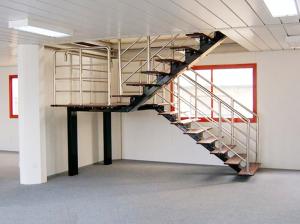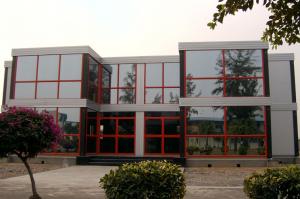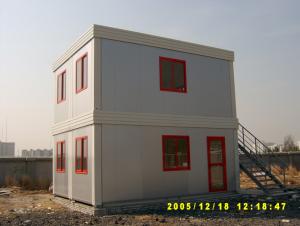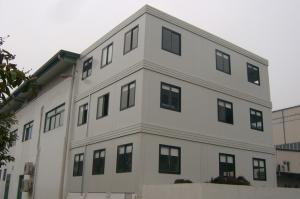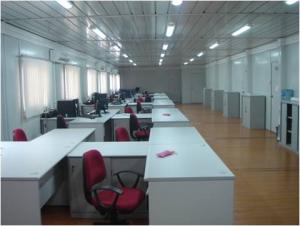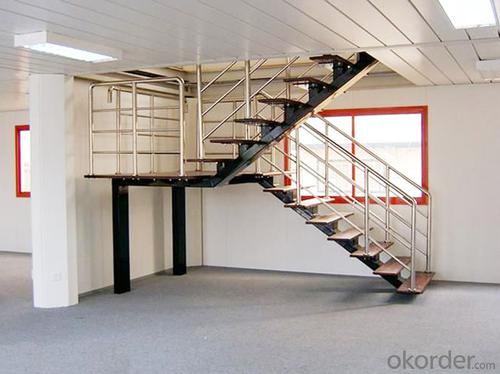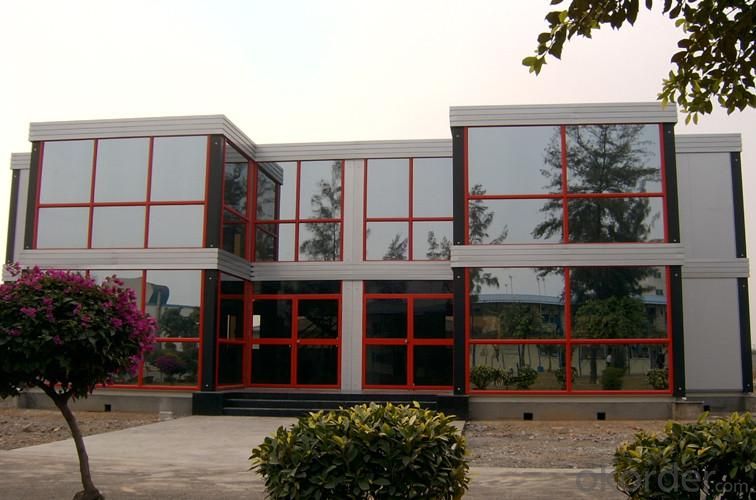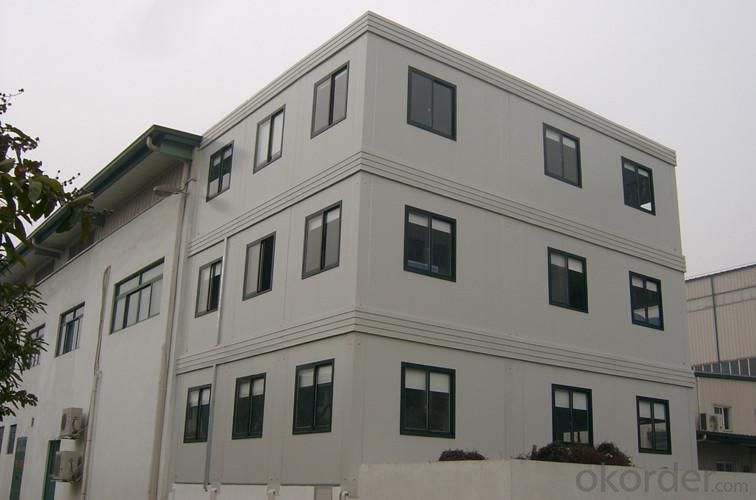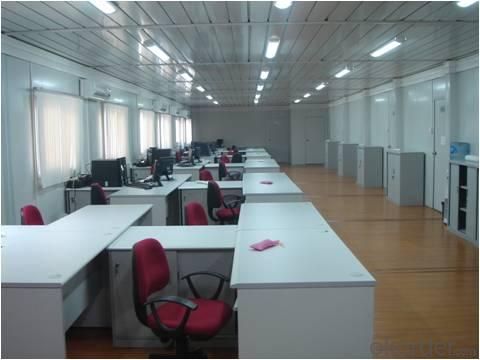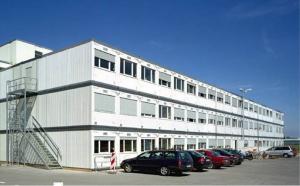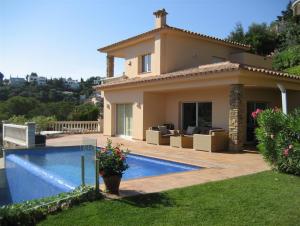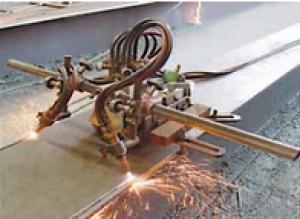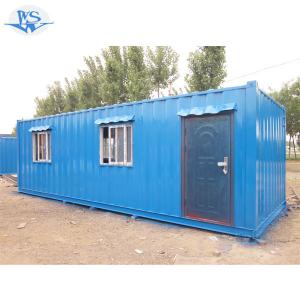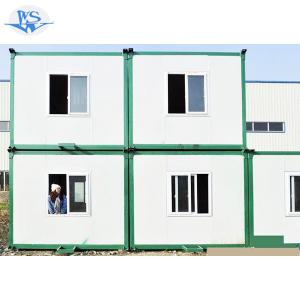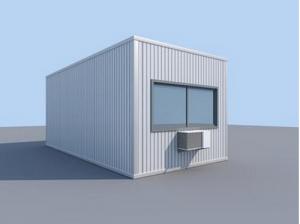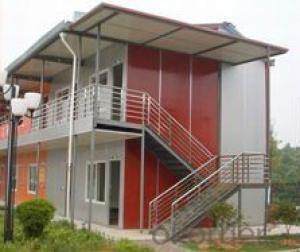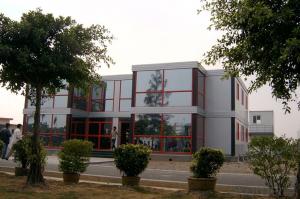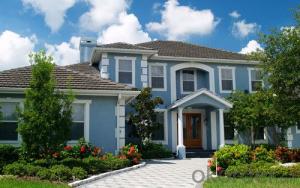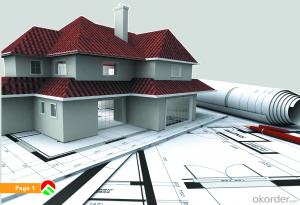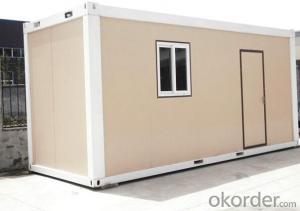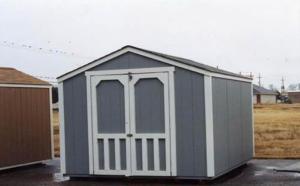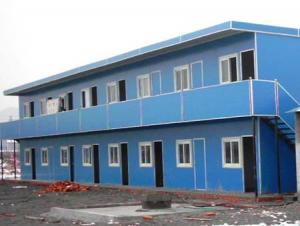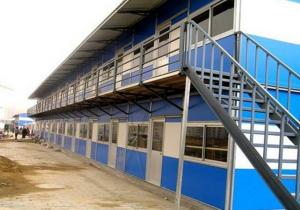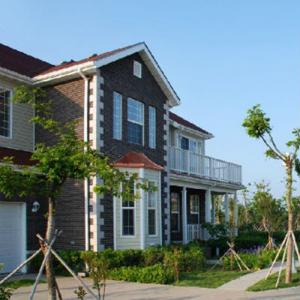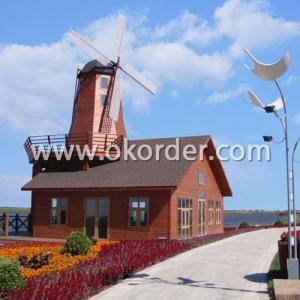Prefabricated House of Office Building Prefab Office
- Loading Port:
- Tianjin
- Payment Terms:
- TT or LC
- Min Order Qty:
- 80 m²
- Supply Capability:
- 20000 m²/month
OKorder Service Pledge
OKorder Financial Service
You Might Also Like
Basic Information of Prefabricated House of Office Building
Place of Origin Beijing China (Mainland) Brand Name PEAK HOME Model Number P-P001 Material Sandwich Panel Usage Carport,Hotel, Office Room, Living House, Temporary House, Storage House,Warehouse, Plant Roof Slope or Flat Framework Q235, galvanized "C", "Z", "H" steel Covering panel EPS sandwich panel or rock wook, PU, MGO sandwich panel Size customized Floor height 2.85m Joint way welding & bolts Windproof grade 10 grade (25m/s) Heat conductivity <0.032W/M.K Container volume 280-300sqm/40HQ
Specifications of Prefabricated House of Office Building
1. Easily and fast building
2. Living comfortable
3. Low cost
4. Re-used
Detailed Information of Prefabricated House of Office Building
| No. | Item | Name | Specification |
| 1 | Type | standardization | custom made products,design and manufacture according to client’s demand |
| 2 | disassembly and assembly | not suitable for assemble and disassemble,lower repeating utilization factor. | |
| 3 | Specification | Length: | No limited, increase expansion joint when length more than 200m. |
| 4 | Width: | ≤11m | |
| 5 | Height: | ≤3.0m | |
| 6 | Roof slope: | double slope,1:6-1:4 | |
| 7 | Floors: | 1 floor | |
| 8 | Standard | Ground channel | Galvanized steel panel pressure,steel panel thickness is 0.8mm |
| 9 | Post | Outdoor post is square steel pipe,material is Q235,components make bottom and surface painted process. | |
| 10 | roof beam | Triangle roof frame is welded by square steel pipe,components surface is made rust-proof process. | |
| 11 | purlin | Purlin is square steel pipe,material is Q235,components surface is made rust-proof process. | |
| 12 | wallboard | 75mm~150mm thickness color steel sandwich panel, white color | |
| 13 | roof board | 75~150mm thickness color steel sandwich panel, white color | |
| (Ceiling board) | |||
| 14 | roof tiles | V35-125-350 color steel tiles,blue or red color | |
| 15 | door | sandwich panel door,size:750mm*2000mm; | |
| 16 | window | PVC sliding window,conch model | |
| 17 | Options | ceiling | roof board is also ceiling board, so this house don’t need to make ceiling again. |
| 18 | canopy | color steel sheet or color steel sandwich panel canopy | |
| 19 | door | compound wooden door,security door,aluminium alloy door | |
| 20 | Electrical accessories | Supply plan,design and construction according to relevant national norms (220V,50Hz,with lamp, switches and multi-function sockets.) | |
| 21 | Water plumbing accessories | Supply plan,design and construction according to relevant national norms | |
| 22 | Sanitary ware | Supply according to customer needs | |
| 23 | Furniture and electrical appliance | Design according to client’s needs | |
| 24 | Desigh | roof dead load | 0.3KN/Sqm |
| 25 | Parameter | roof live load | 0.5KN/Sqm |
| 26 | wind load | 9 degree,wind load:0.35KN/Sqm,design speed:24m/S(Chinese standard) | |
| 27 | Earthquake resistant intensity | 6 degree | |
| 28 | used temperature | Celsius:-25~+50 | |
| 29 | Installation | Tools | electric drill,pulling rivet,electric hammer,spanner,screwdriver etc,need power to install the house |
| 30 | Efficiancy | Four skilled labor one day can erect 40m2’s house body | |
| 31 | Transport | Container | each 40ft container could load 130~150Sqm house body material |
Pics of Prefabricated House of Office Building
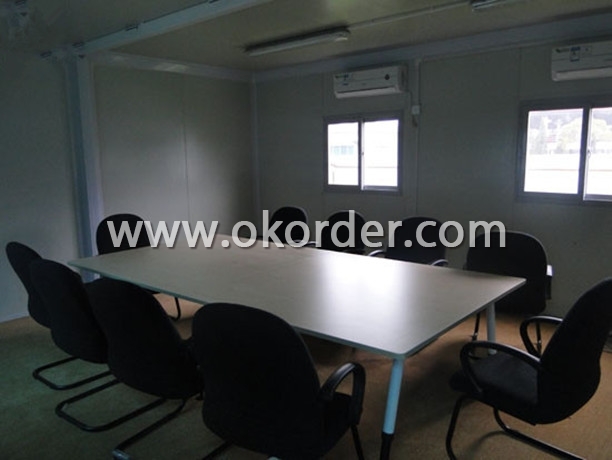
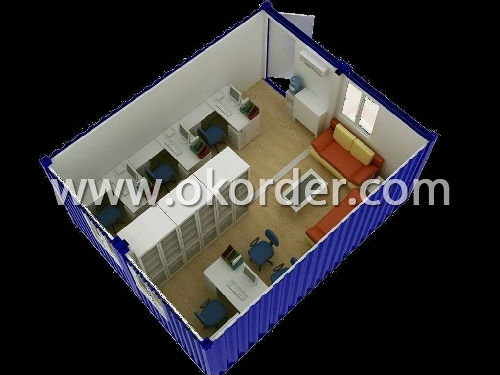
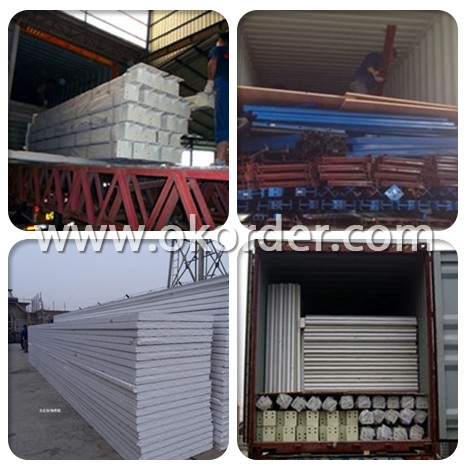
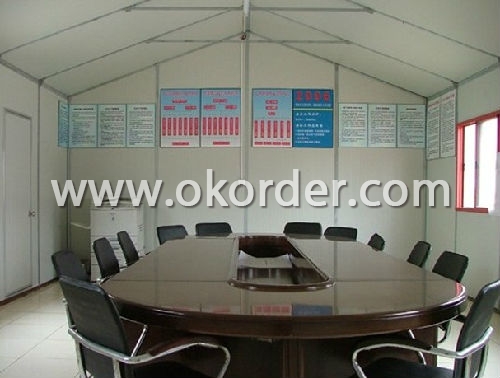
- Q: What is the difference between a rural house and a villa?
- the villa do not talk about a parking garage, a swimming pool, a small garden, each suite has toilet washroom
- Q: Are container houses resistant to extreme temperatures?
- The ability of container houses to withstand extreme temperatures is determined by the particular construction and insulation methods employed. While shipping containers are composed of heat and cold-conducting steel, they can be modified to effectively insulate against extreme temperatures. Insulation materials such as foam or spray foam can be used to line the container's walls and roof, thereby regulating internal temperature and minimizing heat transfer. Additionally, the installation of double-glazed windows, solar panels, and efficient HVAC systems can further optimize temperature control. However, it is important to acknowledge that the insulation and temperature resistance of container houses may vary depending on construction quality, location, and specific climate conditions. Proper planning, design, and insulation techniques are crucial in ensuring the resistance of container houses to extreme temperatures.
- Q: Can container houses be designed to have a music recording studio?
- Absolutely! It is completely possible to design container houses that feature a music recording studio. By carefully planning and designing, a container house can be transformed into an efficient and functional recording space. The key lies in ensuring proper soundproofing and acoustic treatment within the container, creating a controlled environment for music production. To achieve soundproofing, insulation materials can be added to the walls, floors, and ceiling, effectively reducing external noise interference. On the other hand, acoustic treatment focuses on optimizing the internal acoustics by utilizing materials that absorb, diffuse, or reflect sound waves, resulting in a well-balanced and controlled sound environment. Furthermore, the layout and design of the container house can be customized to accommodate the necessary equipment and infrastructure for a recording studio. This may involve incorporating soundproof booths or vocal booths, a control room with appropriate acoustic treatment, and the installation of wiring for audio equipment and instruments. It is crucial to seek advice from experienced professionals in music recording studio design to ensure all technical aspects, including electrical requirements, ventilation, and proper equipment placement, are considered during the design process. Ultimately, container houses offer a cost-effective and unique solution for musicians and music producers seeking a dedicated space for their creative work, making it entirely feasible to include a music recording studio within their design.
- Q: Are container houses customizable?
- Yes, container houses are highly customizable. One of the major advantages of container houses is their versatility and adaptability to different design preferences and needs. These houses can be easily modified and customized to suit individual preferences, whether it's for a single container or multiple containers combined to form a larger living space. The customization options for container houses are vast. They can be designed to include various features such as windows, doors, skylights, or even balconies. The interior layout can be tailored to accommodate different room arrangements, including bedrooms, bathrooms, kitchens, and living spaces. Additionally, container houses can be customized with insulation and heating systems to ensure a comfortable living environment. Container houses can also be customized in terms of aesthetics. They can be painted in different colors, adorned with various cladding materials, or decorated with plants, artwork, or other personalized touches. The exterior design can be modified to create a unique and visually appealing appearance. Furthermore, container houses can be easily expanded or modified as needed. Additional containers can be added or removed, allowing for flexibility in size and layout. This makes container houses particularly suitable for those who may need to adjust their living space over time. Overall, the customizable nature of container houses provides individuals with the freedom to create a unique and personalized living space that reflects their style and meets their specific requirements.
- Q: Can container houses be designed with a kitchenette?
- Yes, container houses can be designed with a kitchenette. With proper planning and design, containers can be transformed into functional living spaces that include a kitchenette area. This can involve installing appliances, countertops, cabinets, and other necessary features to create a fully functional kitchen within a container house.
- Q: Can container houses be expanded or modified in the future?
- Yes, container houses can be expanded or modified in the future. Due to the modular nature of containers, it is relatively easy to add additional units to increase living space. Moreover, containers can be stacked or rearranged to create new configurations. Additionally, containers can be modified by adding windows, doors, or partitions to accommodate changing needs or preferences. Overall, container houses offer flexibility for expansion and modification.
- Q: Can container houses be designed to have a rooftop bar?
- Yes, container houses can be designed to have a rooftop bar. With proper planning and design, it is possible to incorporate a rooftop bar into a container house. The strength and structural integrity of the containers can be reinforced to support the weight of a rooftop bar. Additionally, modifications can be made to create a spacious and comfortable rooftop area, complete with seating, a bar counter, and even a small kitchenette. The containers can be stacked or arranged in a way that allows for easy access to the rooftop area, ensuring a seamless transition between the interior and the rooftop bar. By utilizing creative design and engineering techniques, container houses can be transformed into unique and stylish spaces that include a rooftop bar.
- Q: What sizes do container houses come in?
- Container houses are available in various sizes to meet different needs and preferences. The most common sizes for container houses are 20 feet and 40 feet in length. Typically, a 20-foot container house provides about 160 square feet of living space, while a 40-foot container house offers around 320 square feet. Nevertheless, it is also possible to customize container houses to suit specific requirements. Multiple containers can be combined to create larger living spaces, or they can be stacked vertically to build multi-story homes. Some container houses even have extensions or modules to increase the overall living area. Ultimately, the size of a container house depends on individual needs, available space, and budget limitations. Whether one desires a compact and minimalist living space or a more spacious and luxurious container home, there are various size options available to accommodate different lifestyles and design preferences.
- Q: Are container houses hurricane-resistant?
- Container houses have the potential to be hurricane-resistant when they are designed and built appropriately to endure extreme weather conditions. Housing containers are typically constructed using sturdy steel and possess a robust structure capable of withstanding strong winds and heavy rainfall. It is important to consider, however, that the level of hurricane resistance may vary depending on factors such as construction quality, foundation type, and house design. Enhancing the hurricane resistance of container houses can be achieved through various reinforcements, such as incorporating additional steel supports or employing reinforced concrete foundations. Furthermore, implementing protective measures like hurricane shutters or impact-resistant windows can offer additional defense against flying debris during hurricanes. Overall, by employing proper construction techniques and taking necessary precautions, container houses can withstand hurricane-force winds and provide a secure living environment in areas prone to hurricanes.
- Q: Can container houses be built with a washer and dryer?
- Indeed, it is possible to construct container houses with a washer and dryer. Although the interior space of a container may be limited, there exist innovative approaches to integrating these appliances into the design. In the case of smaller container houses, one can install a washer-dryer combo, which is a combined unit that performs both washing and drying functions, thereby optimizing space. Furthermore, certain container house designs feature a distinct laundry area or a designated section specifically designed for a stackable washer and dryer arrangement. By meticulously planning and utilizing the available space, container houses can certainly accommodate a washer and dryer.
1. Manufacturer Overview
| Location | Nanjing, China |
| Year Established | 2000 |
| Annual Output Value | Below US$1 Million |
| Main Markets | Mid East; Eastern Europe; North America |
| Company Certifications | ISO 9001:2008 |
2. Manufacturer Certificates
| a) Certification Name | |
| Range | |
| Reference | |
| Validity Period |
3. Manufacturer Capability
| a) Trade Capacity | |
| Nearest Port | Shanghai |
| Export Percentage | 51% - 60% |
| No.of Employees in Trade Department | 50-60People |
| Language Spoken: | English; Chinese |
| b) Factory Information | |
| Factory Size: | 10,000 square meters |
| No. of Production Lines | Above 3 |
| Contract Manufacturing | OEM Service Offered; Design Service Offered |
| Product Price Range | Average |
Send your message to us
Prefabricated House of Office Building Prefab Office
- Loading Port:
- Tianjin
- Payment Terms:
- TT or LC
- Min Order Qty:
- 80 m²
- Supply Capability:
- 20000 m²/month
OKorder Service Pledge
OKorder Financial Service
Similar products
Hot products
Hot Searches
Related keywords
